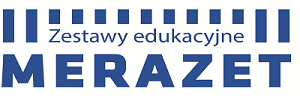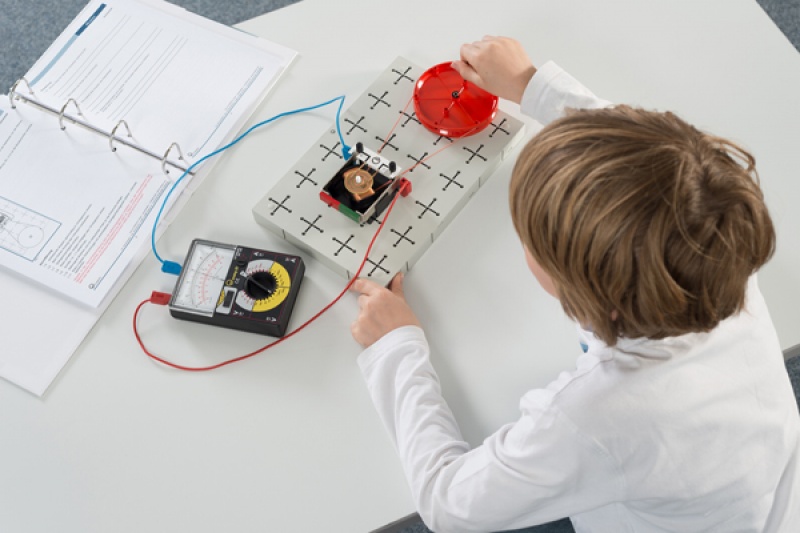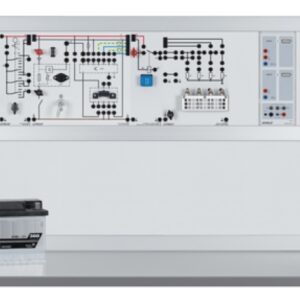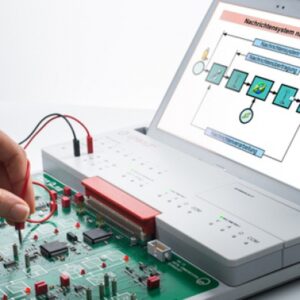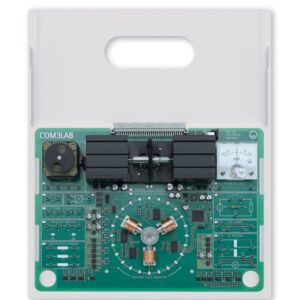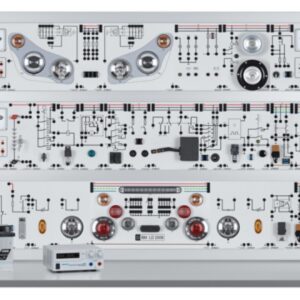Opis
Eksperymenty są przeprowadzane przy użyciu systemu wtyczek STE Electricity/Electronics.
Cele
- Poznanie podstawowych zasad fizycznych
- Implementacja obwodów elektrycznych zgodnie ze schematami
Samodzielny montaż maszyn elektrycznych jest szczególnie skuteczny w budowaniu zrozumienia działania silników i generatorów. Na przykład, proces komutacji i związane z nim siły mogą być rozumiane intuicyjnie i są szczególnie wyraźne, gdy maszyny obracają się powoli.
Zestaw sprzętu zawiera eksperymenty dla uczniów, które można bezpiecznie przeprowadzić w laboratorium przy użyciu bezpiecznego bardzo niskiego napięcia. Instrukcje eksperymentów są zawarte w podręczniku w formie drukowanej lub cyfrowej.
Grupą docelową są uczniowie szkół ogólnokształcących lub zawodowych. Eksperymenty zostały zaprojektowane jako wprowadzenie na prostym poziomie zrozumienia.
Dla bardziej zaawansowanych zalecane są następujące zestawy:
- E2.1.1.1 Elektromagnetyzm & indukcja
- E2.1.1.2 Transformatory trójfazowe
- E2.1.1.3 Prostowanie trójfazowe
Tematy
- Pole magnetyczne stojana
- Pola magnetyczne wirników
- Jak wirniki reagują w polu magnetycznym stojana
- Indukcja elektromagnetyczna przy użyciu magnesu sztabkowego i cewki
- Dynamos
- Generatory uniwersalne – zasada działania/właściwości eksploatacyjne
- Generatory elektrowni
- Generatory AC/DC ze stojanem elektromagnetycznym
- Silniki prądu stałego – zasada działania/pobór mocy
- Silniki prądu stałego ze stojanem elektromagnetycznym
- Silniki uniwersalne z uzwojeniem bocznikowym
- Silniki uniwersalne szeregowe – zasada działania/pobór mocy
- Silniki synchroniczne
- Silniki elektroniczne
Komponenty zestawów urządzeń
| 588 871S | Zestaw zaawansowanej nauki – zestaw BEL | 1 |
| 588 875S | Zestaw zaawansowanej nauki – zestaw ELI 1 | 1 |
| 588 876S | Zestaw zaawansowanej nauki – zestaw ELI 2 | 1 |
| 588 877S | Zestaw zaawansowanej nauki – zestaw ELI 3 | 1 |
| 522 621 | Generator funkcyjny S 12 | 1 |
| 685 48ET5 | Baterie 1,5 V (D, mono), zestaw 5 sztuk | 1 |
| 531 120 | Multimetr LDanalog 20 | 2 |
| 459 32 | Świece, zestaw 20 sztuk | 1 |
| 505 07 | Żarówki, 4 V/0,16 W, E10, zestaw 10 sztuk | 1 |
| 505 08 | Żarówki, 12 V/3 W, E10, zestaw 10 sztuk | 1 |
| 505 11 | Żarówki, 2,5 V/0,25 W, E10, zestaw 10 sztuk | 1 |
| 550 42 | Drut oporowy Constantan, średnica 0,35 mm, 100 m | 1 |
| 550 46 | Drut oporowy chromowo-niklowy, średnica 0,25 mm, 100 m | 1 |
| 550 47 | Drut oporowy chromowo-niklowy, średnica 0,35 mm, 100 m | 1 |
| 550 51 | Żelazny drut oporowy, średnica 0,2 mm, 100 m | 1 |
| 578 39 | Kondensator (elektrolityczny), 100 µF, STE 2/19 | 1 |
| 578 40 | Kondensator (elektrolityczny), 470 µF, STE 2/19 | 1 |
| 667 017 | Nożyczki, 125 mm, okrągłe | 1 |
| 340 900 | Pierścienie gumowe, zestaw 50 sztuk | 1 |
| 340 811ET2 | Osie wtykane, zestaw 2 sztuk | 1 |
| 340 921ET2 | Koło pasowe 100 mm Ø, wtykowe, para, zestaw 2 sztuk | 1 |
| 501 44 | Przewody połączeniowe, 19 A, 25 cm, czerwony/niebieski, para | 3 |
| 501 45 | Przewód połączeniowy, 19 A, 50 cm, czerwony/niebieski, para | 2 |
| 501 441 | Przewód połączeniowy, 19 A, 25 cm, czarny, para | 1 |
| 588 36DE | LIT: PS3.6 Electricity – Motors, German | 1 |
| 588 36EN | * LIT: PS3.6 Silniki i generatory | 1 |
Artykuły oznaczone * nie są niezbędne, jednak zalecamy ich użycie w celu przeprowadzenia eksperymentu.
